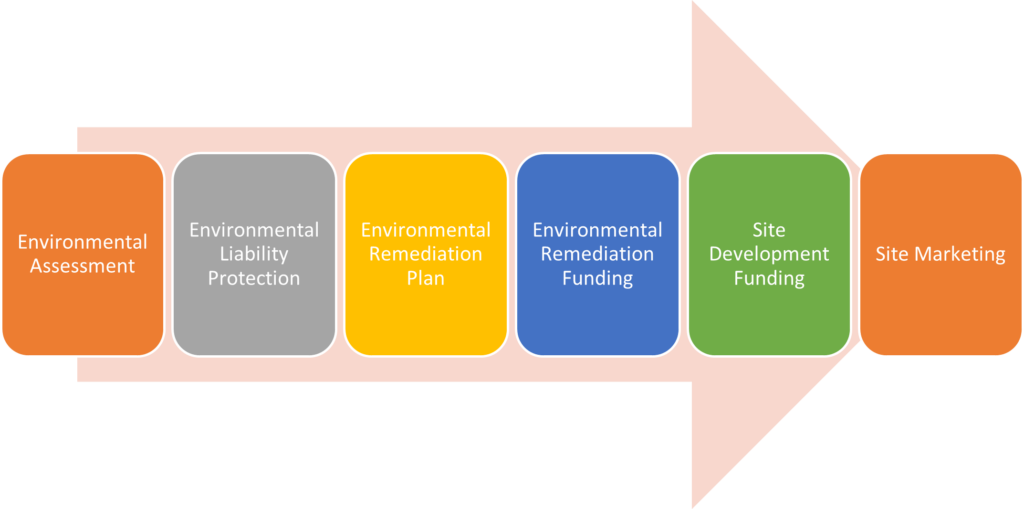The state of Ohio’s recently passed operating budget recently passed included substantial funding for a newly created $350 M brownfield redevelopment program.
Brownfields are real property, and the expansion, redevelopment or reuse may be complicated by the presence of hazardous substances. Brownfield sites are sites contaminated by petroleum or petroleum products, sites contaminated by controlled substances, and mine‑scarred lands. [i] However, Brownfield programs exclude facilities listed on the National Priorities List (U.S. EPA Superfund List), facilities subject to unilateral administrative orders, and facilities subject to the jurisdiction, custody or control of the United States government.[ii] Federal and state environmental laws create liability for contamination at sites that prohibit and freeze development. Federal law creates liability for the environmental contamination of a site—even if the owner did not cause the contamination. Under federal law, a property owner can establish a “bona fide prospective purchaser defense” before purchasing the property if a property owner can establish that a release or threatened release was caused by the act or omission of a contractually unrelated third party.[iii] The prospective property owner cannot be contractually related to prior owners or know about hazardous substances.[iv] To obtain protection, the prospective owner must undertake all appropriate inquiries into the previous ownership and uses of the property consistent with good commercial and customary practice.[v] For liability purposes and potential grant and other government funding opportunities, the prospective owner will hire an environmental consultant to perform Phase I and Phase II reviews of the site.
| Montrose Group Brownfield Redevelopment Process |

450,000 Brownfields exist in the United States.[vi] The redevelopment of Brownfield sites create economic development opportunities and promote the concept of building within the existing regional footprint without sprawling further out. The majority of Brownfields are waiting for redevelopment, and many are in highly sought-after locations surrounded by infrastructure and customers. The Brownfield redevelopment process involves addressing environmental remediation as well as utilizing addressing traditional site development needs. The first step is to deliver an assessment of the environmental damage at a site. These environmental assessments are provided in a Phase I and Phase II approach with the end result being the development of a remediation plan. Grants to gain an environmental assessment of up to $200,000 are available to municipalities and quasi-governmental entities that bear no responsibility for causing the contamination at a site from the federal government. These competitive grants are available on an annual basis for planning and assessment of Brownfield sites contaminated with petroleum or hazardous substances. The federal government offers a number of Brownfield remediation funds through the U.S. Environmental Protection Agency. Ohio offers an impressive Brownfield redevelopment process that provides liability protection through a long-established Voluntary Action Program that can result in liability protection for uses with “clean-hands” as well as a 100% property tax abatement that is central to redeveloping the site.
The state operating budget creates the Brownfield Remediation Program within the Ohio Department of Development to award grants for the remediation of Brownfield sites throughout Ohio. The legislation requires the Director of Development to reserve $1.0 M in funding for each county ($88.0 M statewide) or a proportionate share for each county if the amount appropriated for the program is less than that amount. It specifies that these amounts are reserved for one calendar year from the date of the appropriation, after which they become available for other projects statewide and that the amounts which are not reserved be awarded on a first come, first served basis. The Ohio Brownfield Remediation Program will limit the amount of grants distributed from non-reserved funds to 75% of a project’s cost.
The Ohio Department of Development’s Brownfield Remediation Program creates $350 M in much-needed redevelopment opportunities. Montrose Group leaders have represented public and private sector parties to gain regulatory relief and funding for Brownfield redevelopment projects, and please contact Dave Robinson at [email protected] if you need assistance in redeveloping Brownfield sites.
[i] Retrieved from http://www.epa.gov/swerosps/bf/laws/2869sum.htm.
[ii] Ibid.
[iii] Retrieved from http://www.epa.gov/swerosps/bf/laws/2869sum.htm.
[iv] Retrieved from http://www.epa.gov/swerosps/bf/laws/liability/index.htm.
[v] Ibid.
[vi] https://archive.epa.gov/pesticides/region4/landrevitalization/web/html/brownfieldsites.html